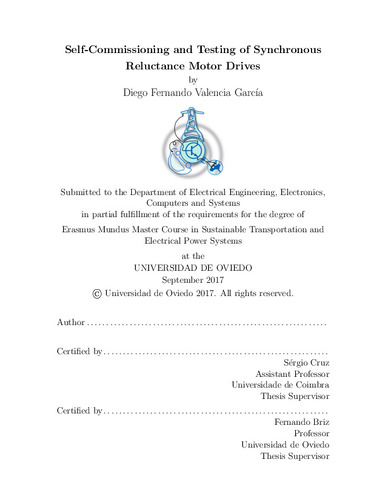Self-commissioning and testing of synchronous reluctance motor drives
Autor(es) y otros:
Director(es):
Palabra(s) clave:
Synchronous reluctance motor drives
Predictive current control
Self-commissioning
Apparent and incremental inductances
Saturation and cross-saturation
Current injection test
Fecha de publicación:
Serie:
Máster Universitario Erasmus Mundus en Transporte Sostenible y Sistemas Eléctricos de Potencia (EMMC STEPS)
Descripción física:
Resumen:
The self-commissioning of synchronous reluctance motor (SynRM) drives was studied in this work. The main objective was the analysis of standstill identification strategies of the magnetic model of SynRMs. Two experimental techniques based on current injection were adopted and tested for the calculation of the apparent and incremental inductances, considering saturation and cross-saturation effects. Sinusoidal and square wave current injection techniques were applied to two 3 kW SynRMs from different manufacturers, in laboratory conditions, based on a predictive current control strategy. The motors were fed by an inverter with a sequence of sinusoidal and square wave current pulses that are first applied on the rotor d- and q-axes separately, at different dc currents on the q- and d-axes, respectively. The procedure exploits a quasi-standstill condition obtained by imposing fast torque oscillations. The stator flux linkage was estimated by integrating the motor induced voltages. Using the current and flux samples, a polynomial representation of the flux as a function of the current was defined, which allows to calculate apparent and incremental inductances by operating the polynomial functions. The accuracy of the obtained inductance values was evaluated experimentally in a test rig, running the SynRM drives in torque control mode by a predictive current control (PCC) strategy. The performances of the drives using the parameters from the two self-commissioning strategies was compared based on the current prediction error and the THD of the motor supply currents. Results were not considerably different using either the inductance profile obtained from sinusoidal current injection or square wave current injection tests, but the test and post-processing were more challenging using square waveforms. Sinusoidal current injection test was then chosen as the technique to be applied to a 11 kW ABB SynRM due to its simpler procedure and accurate results. The 11 kW motor was tested under no-load condition and considering restrictions given its higher rated power and current. The adopted strategy is simple and can be performed at stand-still by injecting a proper current stimulus. Moreover, it does not require any additional hardware and the motor can be coupled or not to the mechanical load. Finally, the thesis concludes with future prospects for further investigation
The self-commissioning of synchronous reluctance motor (SynRM) drives was studied in this work. The main objective was the analysis of standstill identification strategies of the magnetic model of SynRMs. Two experimental techniques based on current injection were adopted and tested for the calculation of the apparent and incremental inductances, considering saturation and cross-saturation effects. Sinusoidal and square wave current injection techniques were applied to two 3 kW SynRMs from different manufacturers, in laboratory conditions, based on a predictive current control strategy. The motors were fed by an inverter with a sequence of sinusoidal and square wave current pulses that are first applied on the rotor d- and q-axes separately, at different dc currents on the q- and d-axes, respectively. The procedure exploits a quasi-standstill condition obtained by imposing fast torque oscillations. The stator flux linkage was estimated by integrating the motor induced voltages. Using the current and flux samples, a polynomial representation of the flux as a function of the current was defined, which allows to calculate apparent and incremental inductances by operating the polynomial functions. The accuracy of the obtained inductance values was evaluated experimentally in a test rig, running the SynRM drives in torque control mode by a predictive current control (PCC) strategy. The performances of the drives using the parameters from the two self-commissioning strategies was compared based on the current prediction error and the THD of the motor supply currents. Results were not considerably different using either the inductance profile obtained from sinusoidal current injection or square wave current injection tests, but the test and post-processing were more challenging using square waveforms. Sinusoidal current injection test was then chosen as the technique to be applied to a 11 kW ABB SynRM due to its simpler procedure and accurate results. The 11 kW motor was tested under no-load condition and considering restrictions given its higher rated power and current. The adopted strategy is simple and can be performed at stand-still by injecting a proper current stimulus. Moreover, it does not require any additional hardware and the motor can be coupled or not to the mechanical load. Finally, the thesis concludes with future prospects for further investigation
Colecciones
- Trabajos Fin de Máster [5292]
Ficheros en el ítem





